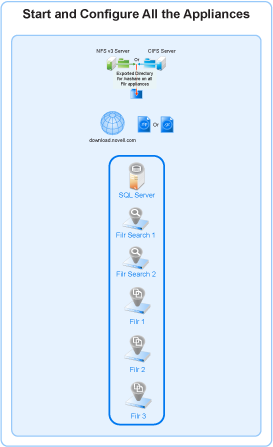|
|
|
-
If you have not already done so, before you begin this process, you must set up shared storage for your Filr appliances by either:
See the Network-Based Shared Disk Space for /vashare section of Worksheet 25 and complete the instructions in Section 4.0, Setting Up Shared Storage before continuing.
|
|
|
|
|
|
|
|
-
After you have downloaded the Filr software and configured your appliances, you must start and configure each appliance in turn.
|
|
|
|
-
After the appliance boots, the License Agreement screen displays.
|
|
License Agreement |
-
Select your preferred keyboard layout in the drop-down.
-
(Optional) use the drop-down to change the license language.
-
(Optional) use the drop-down to change the keyboard layout.
-
Accept the license agreement.
|
|
Passwords and Time Zone |
-
On the configuration page, specify the following information:
IMPORTANT:Keep a confidential record of the passwords you set for the root and vaadmin users below.
Consider using a different password for each appliance for enhanced security.
Example: time.example.com.
For the best results, set up NTP in accordance with the VMware best practices guidelines.
-
Click .
|
|
Network Settings |
-
Specify the following:
Example: myFilr.mynetwork.example.com.
Example: 172.17.2.3.
Example: 255.255.255.0.
Example: 172.17.2.254.
IMPORTANT:Filr appliances do not tolerate latency and should be installed in the same subnet or a near-subnet.
Example: 172.17.1.1.
-
Click .
|
|
Additional LAN Card Configuration |
-
(Conditional) If you configured multiple network adapters for this appliance, select from the following options, then click :
|
|
Data Store Location |
-
Hard Disk 2 is automatically detected and the disk designation is displayed in the hard drive drop-down.
Accept the defaults for the other options on this page by clicking .
WARNING:If you have not already created additional disks 2 and 3 for each of your VMs and prepared a shared storage location for your Filr appliances as described in early sections of this guide and in Recording Your Plan in the Filr 3.4 Planning Your Filr Deployment—Best Practices guide, power off the virtual machine and make sure you have the required disk space in place for your deployment before proceeding. Otherwise, there is a substantial risk that your deployment will not meet your organization’s needs.
|
|
Data Log Location |
-
Hard Disk 3 is automatically detected and the disk designation is displayed in the hard drive drop-down.
|
|
Shared Storage Type (Filr only) |
-
If you are configuring a Filrsearch or MySQL appliance, this page doesn’t appear. Go to Configuring Password, Time, and Network Settings.
-
If you are configuring a Filr appliance in an expandable deployment (the default for this guide)
-
Select the option for the type of shared storage ( or ) that you identified and configured in Section 4.0, Setting Up Shared Storage.
-
Click and continue with the steps for the page matching your selection.
-
If you are configuring a small or non-expandable deployment
|
|
Shared Storage NFS Location |
Referring to the work you did in Exporting an NFS Directory for the /vashare Mount Point, do the following:
|
|
Shared Storage CIFS Location |
Referring to the work you did in Creating a CIFS Share for the /vashare Mount Point, do the following:
-
Type the UNC path to the share that you created.
-
Type the user name of the CIFS user that you identified or created.
-
Type the password of the CIFS user.
-
Click .
|
|
Configuring Password, Time, and Network Settings |
-
The settings you have specified are configured, storage is verified, and the appliance starts.
Continue as indicated for your deployment type:
|
